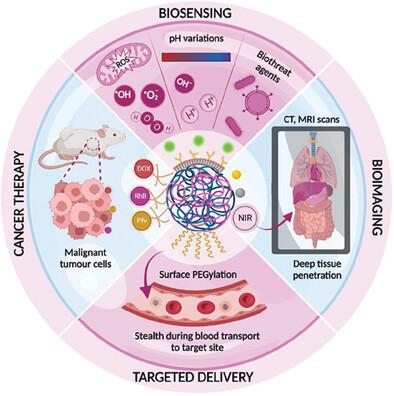Our official English website, www.x-mol.net, welcomes your
feedback! (Note: you will need to create a separate account there.)
Surface Bio-engineered Polymeric Nanoparticles
Small ( IF 13.0 ) Pub Date : 2024-02-23 , DOI: 10.1002/smll.202310876 Laura Libnan Haidar 1, 2 , Marcela Bilek 1, 2, 3, 4 , Behnam Akhavan 1, 2, 3, 5, 6
Small ( IF 13.0 ) Pub Date : 2024-02-23 , DOI: 10.1002/smll.202310876 Laura Libnan Haidar 1, 2 , Marcela Bilek 1, 2, 3, 4 , Behnam Akhavan 1, 2, 3, 5, 6
Affiliation

|
Surface bio-engineering of polymeric nanoparticles (PNPs) has emerged as a cornerstone in contemporary biomedical research, presenting a transformative avenue that can revolutionize diagnostics, therapies, and drug delivery systems. The approach involves integrating bioactive elements on the surfaces of PNPs, aiming to provide them with functionalities to enable precise, targeted, and favorable interactions with biological components within cellular environments. However, the full potential of surface bio-engineered PNPs in biomedicine is hampered by obstacles, including precise control over surface modifications, stability in biological environments, and lasting targeted interactions with cells or tissues. Concerns like scalability, reproducibility, and long-term safety also impede translation to clinical practice. In this review, these challenges in the context of recent breakthroughs in developing surface-biofunctionalized PNPs for various applications, from biosensing and bioimaging to targeted delivery of therapeutics are discussed. Particular attention is given to bonding mechanisms that underlie the attachment of bioactive moieties to PNP surfaces. The stability and efficacy of surface-bioengineered PNPs are critically reviewed in disease detection, diagnostics, and treatment, both in vitro and in vivo settings. Insights into existing challenges and limitations impeding progress are provided, and a forward-looking discussion on the field's future is presented. The paper concludes with recommendations to accelerate the clinical translation of surface bio-engineered PNPs.
中文翻译:

表面生物工程聚合物纳米颗粒
聚合物纳米颗粒(PNP)的表面生物工程已成为当代生物医学研究的基石,提供了一条可以彻底改变诊断、治疗和药物输送系统的变革途径。该方法涉及在 PNP 表面整合生物活性元素,旨在为它们提供功能,使其能够与细胞环境中的生物成分进行精确、有针对性和有利的相互作用。然而,表面生物工程 PNP 在生物医学中的全部潜力受到障碍的阻碍,包括对表面修饰的精确控制、生物环境中的稳定性以及与细胞或组织的持久靶向相互作用。可扩展性、可重复性和长期安全性等问题也阻碍了向临床实践的转化。在这篇综述中,讨论了最近在开发用于各种应用(从生物传感和生物成像到靶向治疗递送)的表面生物功能化 PNP 方面取得的突破背景下的这些挑战。特别关注生物活性部分与 PNP 表面附着的键合机制。表面生物工程 PNP 的稳定性和功效在体外和体内的疾病检测、诊断和治疗中受到严格审查。提供了对现有挑战和阻碍进展的限制的见解,并对该领域的未来进行了前瞻性讨论。本文最后提出了加速表面生物工程 PNP 临床转化的建议。
更新日期:2024-02-23
中文翻译:

表面生物工程聚合物纳米颗粒
聚合物纳米颗粒(PNP)的表面生物工程已成为当代生物医学研究的基石,提供了一条可以彻底改变诊断、治疗和药物输送系统的变革途径。该方法涉及在 PNP 表面整合生物活性元素,旨在为它们提供功能,使其能够与细胞环境中的生物成分进行精确、有针对性和有利的相互作用。然而,表面生物工程 PNP 在生物医学中的全部潜力受到障碍的阻碍,包括对表面修饰的精确控制、生物环境中的稳定性以及与细胞或组织的持久靶向相互作用。可扩展性、可重复性和长期安全性等问题也阻碍了向临床实践的转化。在这篇综述中,讨论了最近在开发用于各种应用(从生物传感和生物成像到靶向治疗递送)的表面生物功能化 PNP 方面取得的突破背景下的这些挑战。特别关注生物活性部分与 PNP 表面附着的键合机制。表面生物工程 PNP 的稳定性和功效在体外和体内的疾病检测、诊断和治疗中受到严格审查。提供了对现有挑战和阻碍进展的限制的见解,并对该领域的未来进行了前瞻性讨论。本文最后提出了加速表面生物工程 PNP 临床转化的建议。































 京公网安备 11010802027423号
京公网安备 11010802027423号